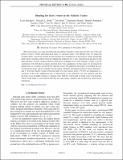Hunting for heavy winos in the Galactic Center
Author(s)
Rinchiuso, Lucia; Moult, Ian; Moulin, Emmanuel; Baumgart, Matthew; Cohen, Timothy; Vaidya, Varun; Rodd, Nicholas Llewellyn; Slatyer, Tracy Robyn; Stewart, Iain W; ... Show more Show less
DownloadPhysRevD.98.123014.pdf (1.222Mb)
PUBLISHER_POLICY
Publisher Policy
Article is made available in accordance with the publisher's policy and may be subject to US copyright law. Please refer to the publisher's site for terms of use.
Terms of use
Metadata
Show full item recordAbstract
Observing gamma rays using ground-based atmospheric Cherenkov telescopes provides one of the only probes of heavy weakly interacting dark matter. A canonical target is the thermal wino, for which the strongest limits come from searches for photon lines from annihilations in the Galactic Center. Irreducible finite energy resolution effects motivate refining the prediction for a wino signal beyond the photon line approximation; recently, modern effective field theory techniques have been utilized to obtain a precise calculation of the full photon energy spectrum from wino annihilation. In this paper, we investigate the implications for a realistic mock H.E.S.S.-like line search. We emphasize the impact of including the non-trivial spectral shape, and we carefully treat the region of interest, presenting results for choices between 1° and 4° from the Galactic Center. Projected limits for wino masses from 1–70 TeV are interpreted as a constraint on the wino annihilation rate, or alternatively as the minimum core size required such that the wino is not excluded. If there is a thermal wino, H.E.S.S. will be able to probe cores of several kpc, which would begin to cause tension between this dark matter candidate and astrophysical observations/simulations.
Date issued
2018-12Department
Massachusetts Institute of Technology. Center for Theoretical PhysicsJournal
Physical Review D
Publisher
American Physical Society
Citation
Rinchiuso, Lucia et al. "Hunting for heavy winos in the Galactic Center." Physical Review D 98, 12 (December 2018): 123014 © 2018 American Physical Society
Version: Final published version
ISSN
2470-0010
2470-0029